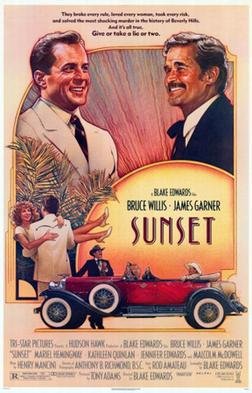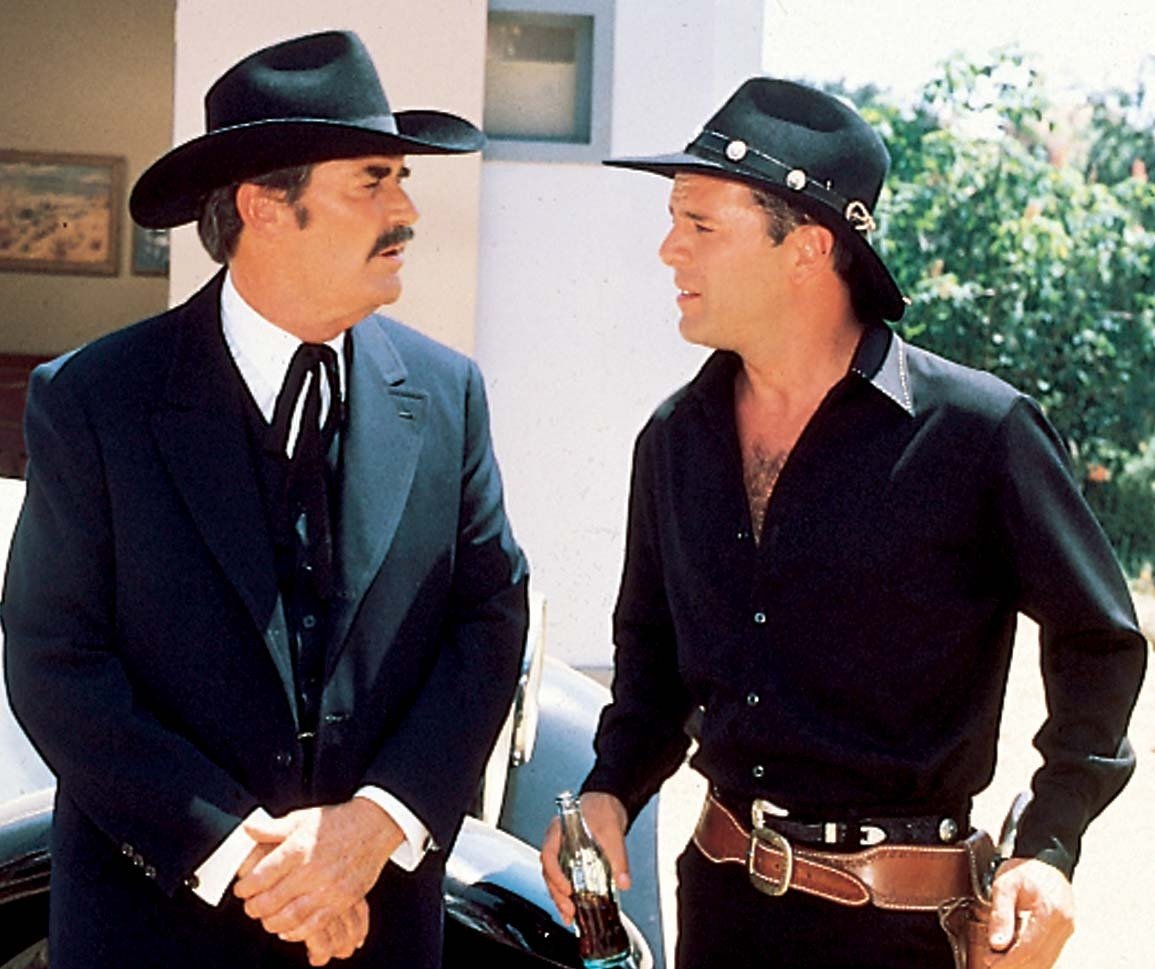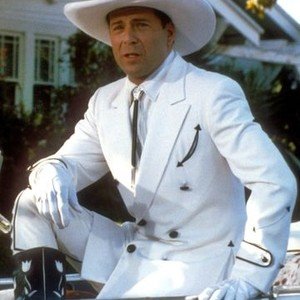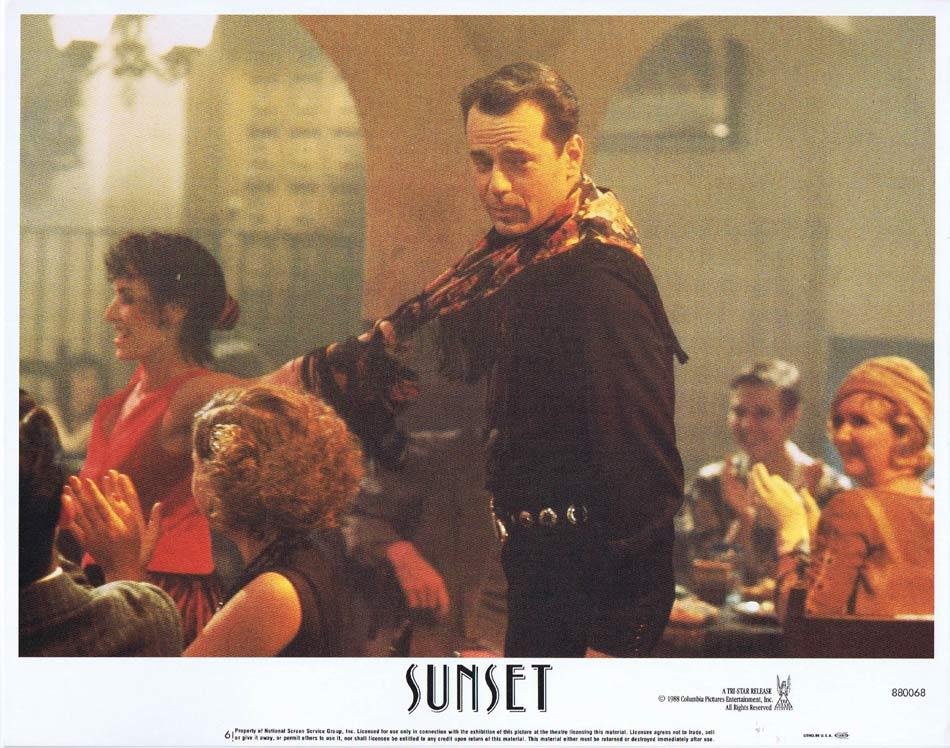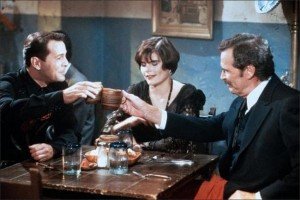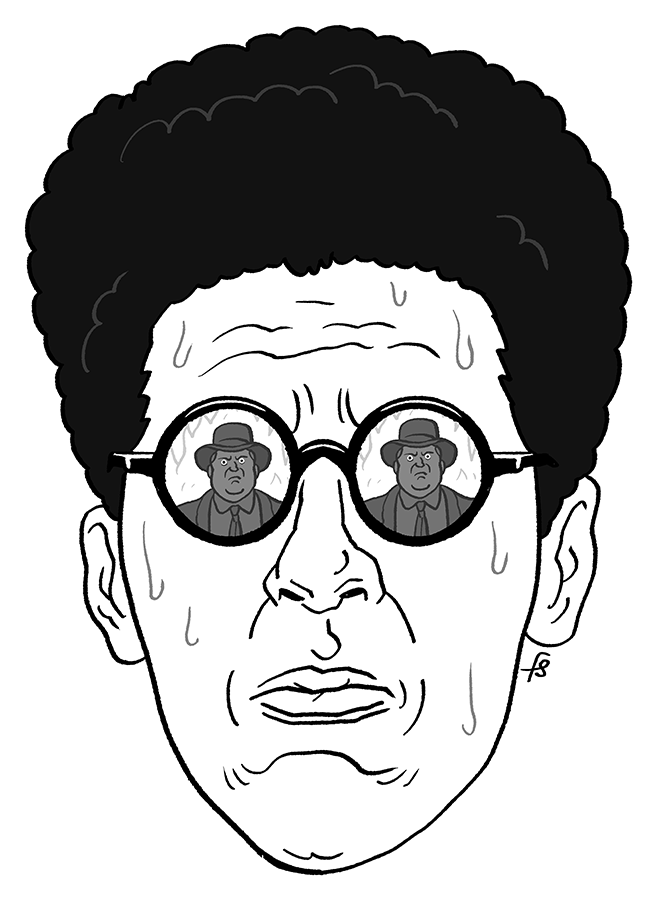Not Even a Brash Early Performance By Bruce Willis Can Save Blake Edwards' Moribund 1988 Western Mystery Sunset
Watching seven of Bruce Willis’ worst and most forgettable movies for my recent Talking About Bruno project instilled in me a fierce desire to see more Bruce Willis movies. But I’ve also felt moved to further explore the man’s life’s work by the heartbreaking if not altogether unexpected revelation that he has been suffering from a condition called aphasia that causes cognitive difficulties and led Willis to retire from acting.
When an icon dies or something terrible happens to them we have a fundamentally healthy, culture-wide need to celebrate of their lives and careers. That’s what’s happening with Willis now. We’re seeing what a profound impact he had on people’s lives, how he defined American masculinity for generations of men.
Willis’ movies have been a huge part of our individual and collective past. I can’t imagine a world without without Die Hard, Pulp Fiction, 12 Monkeys, Unbreakable and The Sixth Sense. These movies are all deeply woven into the fabric of American culture.
As someone who has devoted years of his life to watching and writing about ALL of John Travolta’s movies, even the stinkers, Willis is a central figure due to his presence in both of Travolta’s big comebacks: 1989’s Look Who’s Talking and 1994’s Pulp Fiction.
The boys will be getting back together in the upcoming Paradise City but it’ll be a bittersweet reunion given the thick cloud of tragedy around both men’s lives. I did not write glowingly of the seven films I saw for Talking About Bruno, but the fact that I spent entire weeks watching nothing but famously terrible late-period Bruce Willis speaks to how fascinating I find him and how watchable even his least watchable movies are.
If a nobody makes comically awful low-budget schlock nobody cares. It’s not news. If a mediocrity does the same it’s similarly ignored. But when someone like Bruce Willis makes an endless series of strangely interchangeable direct-to-streaming movies with maddeningly identical casts, titles and premises it becomes newsworthy, as does the reason Willis made all of these exploitation movies in quick succession: his diminished capacity made even the most modestly challenging roles impossible to play.
Now Willis is retiring after a long and distinguished career and we can once again focus on appreciating the great work he did in television and film rather than his sad decline and regrettable late-period output.
Since I am writing a book about American movies about the film industry I figured that I would waste no time getting back to Bruno by covering his movies about making movies, 1988’s Sunset, 1989’s That’s Adequate and 2008’s What Just Happened.
Sunset arrived a strange time in its star’s young film career. A big TV star thanks to Moonlighting, Willis scored a modest commercial success with 1987’s Blind Date and was just a year away from 1989’s Die Hard, which would turn him into a major movie star and an unlikely action hero.
Edwards’ western bombed at the box-office and didn’t fare much better with critics in no small part because it was marketed as something much different than what it actually was.
I went into Sunset assuming that Blake Edwards, who gave the world the Pink Panther in many different iterations of wildly varying quality, and Bruce Willis, the cut-up from Moonlighting, who jointly blessed us with Blind Date just a year before, would return with another broad comedy.
I furthermore assumed that Sunset would follow the rules and conventions of mismatched buddy comedies, including the dictum that the mismatched buddies must loathe each other at the beginning, due to their wildly different personalities and approaches to law enforcement, only to develop an unlikely but sturdy friendship over the course of solving a murder.
I finally went into Sunset thinking that James Garner and Bruce Willis would have roles of equal sizes, or that Willis would have the bigger role, since he was the hot young star of the moment.
I was wrong on all counts. Though it has elements of humor, Sunset is not really a comedy but rather a seedy Neo-Noir set in the glamorous, sordid Hollywood of 1929 as it navigated the uncertain in-between time between the death of the silent screen and the triumph of sound.
Blake Edwards neglected to write any jokes for a Western Comedy-Drama that forgets to be a comedy much of the time. Sunset surprised me with its flagrant disregard for mismatched cop buddy movie convention.
Willis’ flashy silent screen cowboy star Tom Mix and James Garner’s real-world lawman Wyatt Earp like and respect each other from the very beginning, which eliminates an important element of conflict.
Though Sunset was pitched as a Bruce Willis movie with old pro James Garner, the Rockford Files veteran has the more important role and more screen time. Willis is essentially Garner’s sidekick.
If you don’t expect Sunset to be funny it’s still a disappointment but a much more interesting one, as it’s far more effective as a moody riff on old Hollywood and the sordid sensationalism and bleak fatalism of Film Noir than it is as an out and out comedy.
In Sunset, Willis’ Tom Mix is convinced by producer Alfie Alperin (Malcolm McDowell) to make a movie about Wyatt Earp, with the real lawman serving as its headline and publicity-grabbing technical advisor.
McDowell plays the multi-faceted silent screen titan as an evil version of Charlie Chaplin, a beloved movie star due to his genius for physical comedy and lovable hobo alter-ego who is a figure of Satanic evil in his personal life.
The popular clown is a sexual sadist who beats up women, terrorizes men and generally behaves like a show-business Caligula. McDowell’s unnerving performance pulls the film irrevocably in the direction of darkness and death, Chinatown and Noir.
Sunset looks fantastic but it is dramatically inert to an almost perverse degree, a bizarrely joke-light exploration of the sins of the movie world set that’s melancholy and downbeat where you would expect it to be raucous and full of life.
Willis brings a quiet swagger to the role of a beloved movie star who can walk the walk as well as talk the talk. When the screenplay gives him anything to do, he absolutely knocks it out of the park, whether that means getting his ass kicked by a lumbering ox of a man before returning the favor or Tangoing his way through a dance scene with steamy, unexpected sensuality.
It’s easy to forget how handsome and charismatic Willis was at the very beginning of his film career. He wasn’t just good-looking; he was borderline pretty. Willis looks fantastic in Sunset. That’s true of the film as a whole, which is handsomely mounted in the same way a dead animal is handsomely mounted through the magic of taxidermy.
Mariel Hemingway costars as a sad-eyed brothel impresario in androgynous garb who throws herself at Earp, who is old enough to be her grandfather, just as she threw herself at Peter O’Toole, who was old enough to be her dad, in recent Control Nathan Rabin 4.0 entry Creator.
And, of course, who can forget Hemingway’s star-making turn as a 19 year old in love with a man old enough to be her father in Manhattan? I suppose it’s not surprising that middle-aged male screenwriters looked at Hemingway’s beauty, grace and impeccable pedigree as a scion of one of our country’s most legendary families and saw a raving beauty who would love to have sex with them, or at least someone their age.
Sunset very aggressively does not work but it does not work in a surprising way. It fails as a downbeat mood piece rather than a lively buddy comedy. That’s more interesting, but it represents an unmistakable failure all the same.
Failure, Fiasco or Secret Success: Failure
Want a whole massive book full of articles like this, but shorter? Then pre-order the Happy Place’s next book, The Fractured Mirror: Nathan Rabin’s Happy Place’s Definitive Guide to American Movies About the Film Industry here: https://www.kickstarter.com/projects/weirdaccordiontoal/the-fractured-mirror?ref=project_build
The Joy of Trash, the Happy Place’s first non-"Weird Al” Yankovic-themed book is out! And it’s only 16.50, shipping, handling and taxes included, 30 bucks for two books, domestic only!
PLUS, for a limited time only, get a FREE copy of The Weird A-Coloring to Al when you buy any other book in the Happy Place store!
Buy The Joy of Trash, The Weird Accordion to Al and the The Weird Accordion to Al in both paperback and hardcover and The Weird A-Coloring to Al and The Weird A-Coloring to Al: Colored-In Special Edition signed from me personally (recommended) over at https://www.nathanrabin.com/shop
Or you can buy The Joy of Trash here and The Weird A-Coloring to Al here and The Weird Accordion to Al here
Help ensure a future for the Happy Place during an uncertain era AND get sweet merch by pledging to the site’s Patreon account at https://www.patreon.com/nathanrabinshappyplace We just added a bunch of new tiers and merchandise AND a second daily blog just for patrons!
Alternately you can buy The Weird Accordion to Al, signed, for just 19.50, tax and shipping included, at the https://www.nathanrabin.com/shop or for more, unsigned, from Amazon here.
I make my living exclusively through book sales and Patreon so please support independent media and one man’s dream and kick in a shekel or two!

